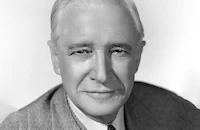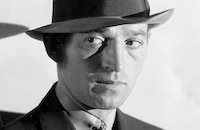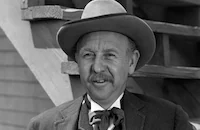Rhythm on the Range

Brief Synopsis
Cast & Crew
Norman Taurog
Bing Crosby
Frances Farmer
Bob Burns
Martha Raye
Samuel S. Hinds
Film Details
Technical Specs

Synopsis
When ranch owner Penelope "Penny" Ryland arrives in New York for a rodeo contest at Madison Square Garden, she convinces her wealthy niece, Doris Halloway, not to marry a man she does not love. Hoping to rid herself of her father's Park Avenue lifestyle, Doris secretly hops Penny's train headed West and finds herself in the boxcar of cowboy and crooner Jeff Larrabee and his prized bull "Cuddles." Although they quarrel, Doris quickly becomes infatuated with Jeff and tells him she is Lois Hall, an unemployed cook. When Doris gives Shorty, a passenger on the train, a telegram for her banker father Robert, Shorty and his gangster friends scheme to take Doris hostage. Meanwhile, Doris and Jeff get left off the train after Doris, wearing a red scarf, is chased by Cuddles. Making their way West camping out of an old car, Doris and Jeff are nearly discovered by the gangsters, but finally arrive at Jeff's home in Green Pastures, Arizona. There, they find Jeff's partner Buck with Macy's salesgirl Emma Mazda, who has come to Frying Pan Ranch to meet her brother Gopher. The next day, Doris confesses her love for Jeff to Buck, who advises her to marry him before telling him who she really is. Later, when Buck and Emma announce their engagement, Buck needles Jeff into proposing to Doris. While the couples celebrate, Penny and Robert arrive by plane, having posted a reward of $5,000 for Doris' return. Finding her engaged to Jeff, Penny accuses him of being a fortune hunter, and Jeff, finally realizing Doris' true identity, leaves on his horse. Doris then offers the gangsters $5,000 to catch Jeff, and the couple is reconciled.

Director

Norman Taurog
Cast

Bing Crosby

Frances Farmer

Bob Burns

Martha Raye

Samuel S. Hinds

Warren Hymer
Lucille Webster Gleason

George E. Stone

James Burke
Martha Sleeper

Clem Bevans

Leonid Kinskey
Charles Williams
Beau Baldwin 50th
Louis Prima

Emmett Vogan
Billy Bletcher
John Eckert
Richard Powell
Ben F. Hendricks
Frank Scully
Eddie Dunn
Eddy Waller

Bud Flannigan
Duke York
James Blaine
Robert E. Homans
Edward Lesaint
Herbert Ashley
James "slim" Thompson
Sam Mcdaniel
Jim Toney
Sid Saylor
Oscar Smith
Dorothy Tennant

Charles E. Arnt
Harry C. Bradley
Otto Yamaoka
Ella Ethridge
Bob Mckenzie

Irving Bacon
Heinie Conklin
Frank Dawson
Jack Rice
Constance Bergen
Crew
Duke Atteberry
J. Keirn Brennan
Bager Clark
Sam Coslow
Walter Deleon
Hans Dreier
A. E. Freudeman
Benjamin Glazer
Edith Head
Billy Hill
Ellsworth Hoagland
Frederick Hollander
Mervin J. Houser
Dev Jennings
Gordon Jennings
Don Johnson
William Lebaron
Francis Martin
William Slavens Mcnutt
Johnny Mercer
Gene Merritt
Jack Mintz
John C. Moffitt
Boris Morros
Ralph Rainger
Leo Robin
Gertrude Rose
Morrie Ryskind
Sidney Salkow
Karl Struss
Robert Usher
Harlan Ware
Eddie Welch
Richard A. Whiting
Waldemar Young
Joe Youngerman
Adolph Zukor

Film Details
Technical Specs

Articles
Rhythm on the Range
Cowboy Jeff Larabee (Crosby) is on his way home after performing in rodeos in Madison Square Garden, when he finds Doris Halloway (Farmer) hiding on the train. Jeff thinks Doris is poor, but in the great tradition on 1930s Hollywood, Doris is actually an heiress running away from an unwanted marriage who is escaping to her aunt Penelope's (Lucile Gleason) ranch.
Shot on location at the Alabama Hills in Lone Pine, California, a well-used location for Westerns, with the rodeo sequence shot at Madison Square Garden in New York City, Rhythm on the Range was directed by Norman Taurog from a screenplay by Jack Moffitt, Sidney Salkow, Walter DeLeon, and Francis Martin, based on a story by Mervin J. Houser. Edith Head, who had worked under Paramount's biggest costumer, Travis Banton, and later became head of costumes after Banton's departure, was in charge of dressing the stars.
Crosby sung many songs in the film, with the most famous being Johnny Mercer's I'm an Old Cowhand from the Rio Grande, which became a cowboy standard. Crosby also sang Roundup Lullaby, Empty Saddles, Drink it Down, and I Can't Escape from You .
Frances Farmer was not the first choice to play Doris; Merle Oberon was slated for the role, but negotiations with Samuel Goldwyn (to whom she was under contract) failed. Jean Arthur, Olivia de Havilland, and Marsha Hunt were also considered before Farmer, who was in the middle of a seven-year contract with Paramount, got the part. Martha Raye had been discovered while appearing at the famous Trocadero nightclub in Hollywood, which resulted in director Norman Taurog ordering a part written for her for the film and signing her to a $1300 a week contract. Rhythm on the Range reunited Raye with Bob Burns from their vaudeville days, where he had bought her an ice cream when she was seven years old.
Raye burst into tears at the premiere of the film at the Paramount Theater in New York in July 1936, as the audience applauded half-way through her You'll Have to Swing It (Mr. Paganini) musical number. She later said she was "[b]awling so hard, I didn't see myself for the rest of the movie." The critics weren't crying when the film was released, they raved about Martha Raye. Frank S. Nugent, who titled his review for The New York Times "Salute a New Comedienne in Rhythm on the Range ," admitted that while Bing Crosby and the film were both good, he preferred "to think of Rhythm on the Range as our screen introduction to Martha Raye. Miss Raye is a stridently funny comedienne with a Mammoth Cave, or early Joe E. Brown, mouth, a dental supply vaguely reminiscent of those frightening uppers and lowers they used to hang over the portals of painless extraction emporia, and a chest which, in moments of burlesque aggressiveness, appears to expand fully ten inches." Rhythm on the Range proved to be a financial hit for Paramount and launched Martha Raye on a career that lasted fifty years.
SOURCES: The Internet Movie Database Nugent, Frank S. "Salute a New Comedienne in 'Rhythm on the Range' at the Paramount" The New York Times 30 July 36 Pitrone, Jean Maddern Take it from the Big Mouth: The Life of Martha Raye Shelley, Peter Frances Farmer: The Life and Films of a Troubled Star

Rhythm on the Range
Quotes
Trivia
Notes
According to a October 4, 1935 Hollywood Reporter news item, the rodeo sequences in this film were shot at Madison Square Garden, New York. This film marked the screen debut of Martha Raye. Bob Burns, a bazooka player from Van Buren, Arkansas, was a radio star and made a hit out of the title song, "Rhythm on the Range," at the time of this film's release. A contemporary source says the film's first premiere sold out within twenty-four hours when Burns was announced as a guest of honor. The Film Daily review calls Raye a "female Joe E. Brown," stating, "with proper material and handling, [she] should go far." Scenarist John C. Moffitt went on leave from the Kansas City Star to write this film. A news item in Hollywood Reporter on January 30, 1936 states that Paramount wanted Merle Oberon to star with Bing Crosby in the film and was negotiating with Samuel Goldwyn to borrow the actress; the negotiations apparently fell through. Although this film was not technically billed as a musical, ads boasted that it contained seven "hit songs." This film was remade by Paramount in 1956 as Pardners, directed by Norman Taurog and starring Dean Martin, Jerry Lewis and Agnes Moorehead.














